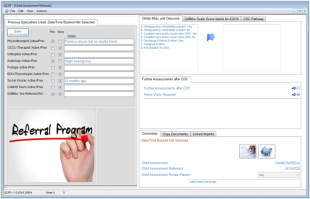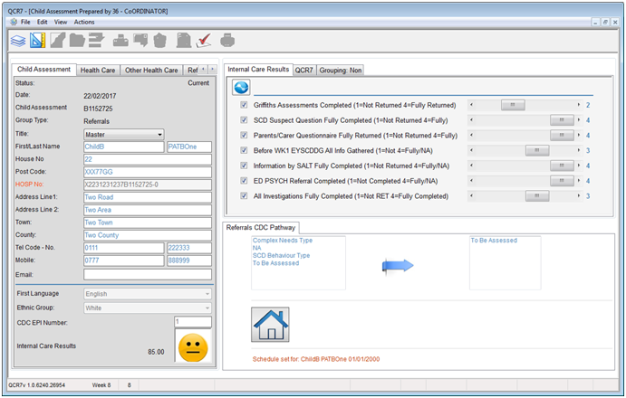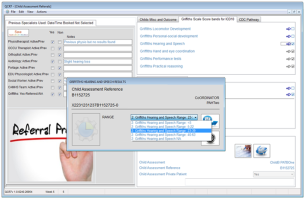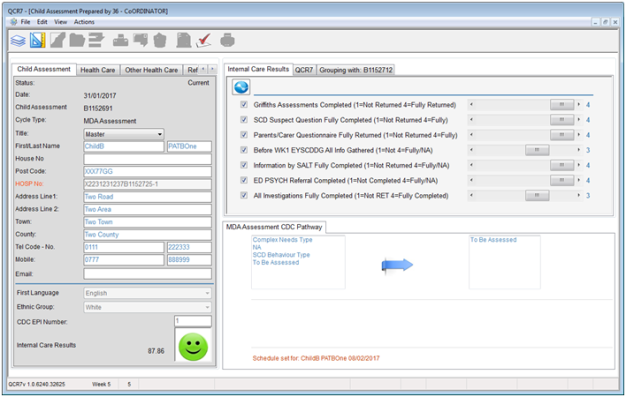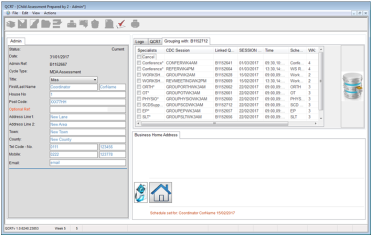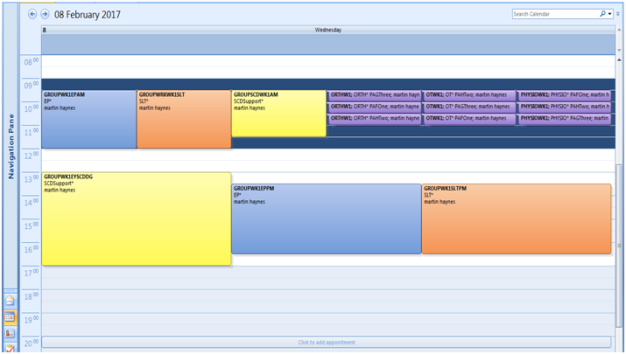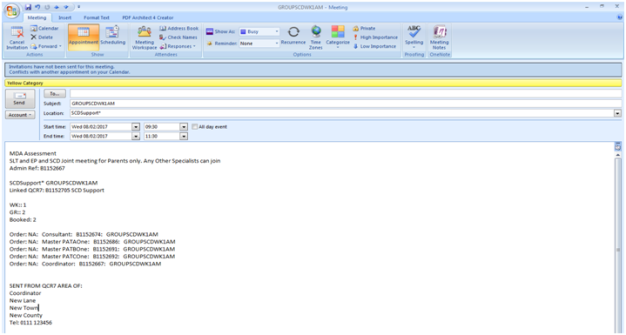

CHILD DEVELOPMENT CYCLES
The following demonstrates a fully working and fully tested in-house system for a child development system when patients have been referred to the Child Development Centre.
CDC Cycle 1 (Referrals)
Patient is referred to the CDC Cycle and the Coordinator is assigned to collect information and start the initial processes of Griffiths tests, Questionnaires, ED SLT and Portage.
CDC Cycle 2 (MDA Assessment)
Starting from Week 1 to Week 4. All patients are to be assessed through PHYSIO, OT, ORTH, EP, SLT or the SCD Group. These Weeks 1-4 are critical dates and are set without change in order manage all
disciplines to be brought together. Parents or carer appointments dates are also set without change with consultants and the necessary specialists.
CDC Cycle 3 (Pathways)
in order for a patient to be assigned a pathway, all assessments should have been completed and returned with questionnaires and the final results where applicable recorded within the new system.
There is also an option to move onto another stage or sign off completely.
REFERRAL AND MDA CYCLES
Since a large part of the system is based around appointments, group appointments with specialists, one to one appointments with
patients and carers or the like, we have colour coded different appointment types and the same colour code category can now be sent to MS Outlook showing all dates, times, specialists, patients and
carers. All appointment types are also viewable as a weekly agenda within the new system.
We have also broken down into three different stages within the system referrals when a new patient has been referred with a standard referral form. This stage is to allow the coordinator to gather
all the information needed about the patient and could take up to several months to complete. This should include contacting the carer of the patient and saving documentation within the new
system.
The next stage is more detailed where the patient is now entering the Multidisciplinary Assessment which involves all specialists, parents or carers, consultants and the coordinators. All of which
are managed through the new system with appointment dates and times and an overview sent to MS Outlook showing appointments from Week 1 to Week 4. When an overview is sent to MS outlook calendar,
this also shows everyone involved including patients one to one with the specialists, group appointments with consultants, specialists and carers appointments.
CDC Cycle 1 (Referrals) Part 1
When a Referral document come through from external sources, we need to input as much detail as possible. The image below
shows the Referral Pathway is to be assessed and our internal care assessments showing if we have “All investigations Fully Completed “has a range of three that is nearly completed. This scale should
be completed when the coordinator manages the patient before week 1 commences and will give a score as below (87.86%) to indicate the current care with an aim of 100%. This also shows the patient
status is “Current” and is under the referrals cycle and almost ready for week 1. Week 5 as below on the image shows the current calendar year week number
(Not the CDC Week Number)
REFERRAL PROGRAM
CDC Cycle 1 (Referrals) Part 6
When a Griffiths Report and assessment has been completed, the results should be recorded here as below using the Score
Bands for ICD-10 as below
CDC Cycle 1 Summary Overview of the Patient at Cycle 1
MDA ASSESSMENT CYCLE
CDC Cycle 2 MDA Assessment
When the CDC Cycle 1 Referral has been signed off to the Cycle 2, the CDC Cycle 1 cannot be edited
and is only used as read only.
The CDC Cycle 2 has most the same functionality as CDC Cycle 1 apart from we can now arrange appointments with all the disciplines including parents, carers and consultants. The CDC Cycle 2 Will also
gives the coordinator the ability to print pre-formatted letters to all departments and parents.
As you can see below, the Patient Reference has changed and this also shows we are now at CDC Cycle 2 (MDA Assessment), and we have updated the Internal Score as we now have all the results
returned for the Griffiths Report.
As the MDA stage is quite complex and many letters need to be sent out through the CDC cycle, we have also developed pre-defined
letters that need to be sent to carers and specialists. These letters are already in a specific format and when printed from the system, these are automatically saved for future use. There is also
the built in functionality that will allow the coordinator to save any other documents used for the patients.
Within the MDA as above, we also record the Griffiths Score Bands for ICD10 from the specialist and whether the patient has been seen by previous specialists including Child Protection, Foster homes,
the child’s school or nursery and other healthcare requirements such as the Main Specialties, first language, and ethnic groups and so on.
The last stage of the cycle is the pathway type for the patient who could be of Complex Needs Type, Individual Needs or a Social Communication Disorder Type. Other Pathways could be added as and when
needed without further system development.
As a truly end to end CDC Cycle, we also feel is also important to measure how well we are doing throughout the year. This is done by completing a monthly or six monthly review with the results
calculated and saved showing a trend over a period of time. As an example, this stage is simply calculated on how many years’ experience we have at our roles or what training has been done in order
to perform effectively and so on. Another example maybe when a new starter has only worked within the CDC Clinic for several months would have less experience than someone working in their role for
several years. The results are calculated as above and showing a monthly percentage of your achievements. This is managed through the coordinator gathering the required information through
managers or consultants and is measuring performances on groups and not individuals.
Within the system, we also measure how efficient externals are performing that involves patients within the system. What we are trying to do here is to measure the care for our patients by measuring
for example, if a patients Griffiths Assessment has been fully completed and returned, or if a parents questionnaire has been fully completed and returned, or if all other questionnaires have been
fully returned. If all questionnaires and all peers have performed very well for each patient, then this will show on the positive side how well we are doing for each patient.
PRIVATE PATIENTS
CDC Cycle 1 Cost Summary
Below shows an example on how the summary is calculated and ready to produce an Invoice if needed.
CDC Cycle 1 Completed
Invoice Example:
CDC Cycle 1 Completed
Payment Example:
CDC CYCLE DISCHARGE SUMMARY
CDC Cycle 1 Completed
Example of the CDC Cycle Discharge Letter
COORDINATORS
CDC Cycle 2 MDA Assessment
The image below shows the coordinator scheduled with all the group meetings. As these group meetings also involve the
patients, then all the linked patients, coordinators and if needed the consultants are all populated within the MS Outlook Calendar for that day.
NOTE: The email image below will prompt the user if they want to send the selected schedule dates
to MS Outlook Calendar.
CDC Cycle 2 MDA Assessment
Once all Schedule dates have been sent to MS Outlook Calendar, this shows how the Calendar is updated.
NOTE: The colour categories in MS Outlook match the colour within the new system and the patient names displaying within the calendar including the specialist type.
CDC Cycle 2 MDA Assessment
This image shows the information that is sent to the default calendar and can be edited if need be.
The information consists of;
The Group Type Meeting (SCD)
Week 1 (Of Group 2)
The patients names and Group Session Codes
Where the Calendar was booked from (In this case from the coordinators area).
Dates
Times
Location
Subject
NOTE: This information could be emailed using a secure email server, or just saved to manage schedules in Outlook
STANDARD LETTERS
CDC Cycle 2 MDA Assessment
Our Week 1 and Week 3 Letter sent to the Parent or Carer
NOTE: Each document has a document version.
DATA DICTIONARY
The following NHS healthcare names and codes are also captured following the NHS Data Dictionary:
Referrer Type and ORG Code
Referral Reason to CHS and CODE
Nursery or School Type and ORG Code
Hospital Name and ORG Code
Practice Name and ORG Code
Practice email
GP Name and CODE
Main Specialty and CODE
Main Consultant and CODE
Treatment Specialty and CODE
ICD-10 Diagnostics and CODE
Valid or not valid VMP and AMP Medicines used and CODE
Medication Status and CODE following HSCI Standards
Child's NHS Number validation checking including Scotland
Child's Mothers NHS Number validation checking including Scotland
Patients DOB
Referral Date
CDC Cycle Episode Dates
Discharge Dates
Religion and CODE
Gender and CODE
Language and CODE
Hospital Number or NEW Unique ID
First Language and CODE
Ethnic Group and CODE
Child Protection
Looked After Child
Social Worker
Interpreter Required
Portage Team and ORG CODE
Health Visitors and ORG CODE
Referrer Type and CODE
Procedure and CODE
Appointment DNA or Attended Reasons and CODE
IT Solutions
Technical Intelligence Ltd can help! Call our tech support line now:
T: 0845 116 1852
Address
Technical Intelligence Ltd
Office 3, Sycamore Trading Estate
Squires Gate Lane
Blackpool
FY4 3RL
Our new website goes online
Thanks for visiting our new website! It provides information about us, our services and IT strategies.
Tweet this page
Tweet




